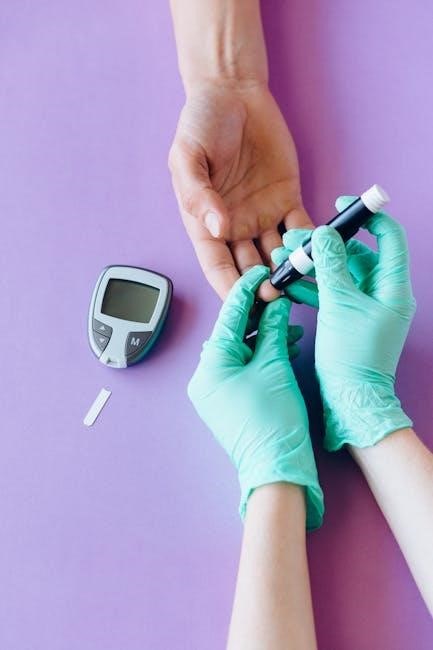Late-Night Salivary Cortisol Test: An Overview
The late-night salivary cortisol test is a convenient screening method․ It assesses the body’s cortisol production․ The test involves collecting saliva at a specific time․ Typically, collection occurs late in the evening․ This helps detect Cushing’s syndrome effectively․

What is a Late-Night Salivary Cortisol Test?
The late-night salivary cortisol test is a diagnostic procedure․ It measures the level of cortisol in saliva collected late at night․ Cortisol, a hormone produced by the adrenal glands, plays a vital role in regulating stress, metabolism, and blood sugar levels․ This test is a non-invasive way to assess adrenal function․
The primary purpose is screening for Cushing’s syndrome, a condition characterized by excessive cortisol production․ Unlike blood tests that require a clinic visit, this test can be conveniently performed at home․ Patients collect saliva samples between 11 PM and midnight over one or two nights․ Elevated late-night salivary cortisol levels suggest potential hypercortisolism․ Further investigations may be warranted to confirm the diagnosis․ The test’s accuracy depends on strict adherence to collection instructions․ Factors like eating, drinking, or brushing teeth shortly beforehand can affect results․
This makes following the guidelines crucial for reliable outcomes․
Why is the Test Performed?
The test screens for Cushing’s Syndrome, marked by excessive cortisol․ It’s a convenient way to assess adrenal function at home․ Elevated levels prompt further investigation․ It helps in identifying potential hormone imbalances effectively․
Screening for Cushing’s Syndrome
The late-night salivary cortisol test is primarily performed to screen for Cushing’s syndrome․ Cushing’s syndrome is a hormonal disorder caused by prolonged exposure to high levels of cortisol, a hormone produced by the adrenal glands․ Identifying Cushing’s early on is crucial for effective management and treatment․
The late-night salivary cortisol test is a valuable tool in the diagnostic process because cortisol levels normally decrease in the evening․ In individuals with Cushing’s syndrome, this natural decline may not occur, resulting in elevated cortisol levels in saliva collected late at night․
This test offers a non-invasive and convenient way to assess cortisol levels at home, reducing the potential for falsely elevated results due to the stress of a clinical setting․ When elevated late-night salivary cortisol levels are detected, further diagnostic testing is typically recommended to confirm the diagnosis and determine the underlying cause of Cushing’s syndrome․ Early detection is extremely important!

Collection Time and Frequency
Optimal collection time is crucial for accurate results․ Typically, saliva collection occurs between 11 PM and midnight․ Often, collection happens over two consecutive nights․ This ensures reliability in assessing cortisol levels for Cushing’s screening purposes․
Collection Between 11 PM and Midnight
Adhering to the specific collection window is paramount for accurate late-night salivary cortisol test results․ The recommended collection time falls strictly between 11:00 PM and midnight․ Collecting saliva before 11:00 PM or after 12:00 AM, midnight, can compromise the test’s validity․ This is a time-sensitive collection․
The body’s cortisol levels fluctuate throughout the day․ Late-night measurements help identify abnormal cortisol production patterns indicative of Cushing’s syndrome․ Variations from the prescribed collection time can lead to misinterpretations․ Therefore, it’s essential to follow instructions meticulously․
This precise timing captures the nocturnal cortisol suppression․ Deviation from the timeframe necessitates repeating the test to ensure reliability․ Accurate timing is the cornerstone of this screening test․
Two Consecutive Nights of Collection
The late-night salivary cortisol test protocol often requires sample collection over two consecutive nights․ This approach enhances the reliability and accuracy of the screening process․ Collecting samples on two separate nights helps account for potential day-to-day variations in cortisol levels․ Single-night collections may be influenced by transient factors․
By obtaining samples over two consecutive nights, healthcare providers gain a more comprehensive understanding of a patient’s cortisol production pattern․ This reduces the likelihood of false positives or false negatives․ It also provides a more stable baseline for comparison․
Consistency in following the collection protocol is crucial․ Any deviations from the instructions, should be reported to the healthcare provider․ Collecting samples on consecutive nights minimizes the impact of isolated events on test outcomes․
Pre-Collection Instructions
Following specific pre-collection instructions is essential for accurate late-night salivary cortisol test results․ These guidelines help minimize factors that could influence cortisol levels․ Adhering to these instructions ensures the reliability of the test․
Avoid Eating or Drinking 15-30 Minutes Before
To ensure the accuracy of your late-night salivary cortisol test, it is crucial to refrain from eating or drinking anything for at least 15 to 30 minutes before collecting your saliva sample․ This restriction helps prevent any potential contamination of the sample․ Food particles or liquids in the mouth can interfere with the cortisol measurement․ This could lead to inaccurate test results․
The presence of food or drink residue may alter the pH of your saliva․ This can affect the stability of cortisol․ Therefore, maintaining a clean oral environment is vital․ This will ensure that the collected sample accurately reflects your cortisol levels․ Avoid chewing gum or using mouthwash during this period․ These products can also introduce substances that affect the test․
By strictly adhering to this guideline, you contribute significantly to the reliability․ This will ensure that the results of your late-night salivary cortisol test are as accurate as possible․ Accurate results are necessary for proper diagnosis and treatment planning․
Do Not Brush Teeth Before Collection
Prior to collecting your saliva sample for the late-night salivary cortisol test, it is imperative to avoid brushing your teeth․ The act of brushing can introduce substances into your oral cavity․ These substances can interfere with the accurate measurement of cortisol levels․ Toothpaste, mouthwash, and even the abrasion from the brush itself may affect the sample․
Many kinds of toothpaste contain ingredients that can contaminate the saliva․ These ingredients may alter the pH or introduce chemicals that affect the cortisol assay․ Furthermore, brushing can sometimes cause minor gum bleeding․ The presence of blood in the saliva sample can also compromise the test results․ Therefore, it is important to refrain from brushing your teeth before the collection․
To ensure the integrity of your sample and the accuracy of the test, strictly adhere to the instruction․ This will make the results more reliable․ Accurate test results are essential for the correct diagnosis and management of conditions․ This contributes to more effective and appropriate healthcare decisions․
Avoid Smoking and Alcohol Before Collection
To ensure the accuracy of your late-night salivary cortisol test, abstaining from smoking and alcohol consumption prior to sample collection is crucial․ Both substances can significantly impact cortisol levels, leading to inaccurate results and potentially misdiagnosis․ Smoking, in particular, introduces nicotine and other chemicals into the body․ These stimulate the adrenal glands, causing a temporary surge in cortisol production․ This artificially elevated level can skew the test results․
Similarly, alcohol consumption affects the hypothalamic-pituitary-adrenal (HPA) axis, which regulates cortisol release․ Alcohol can disrupt the normal cortisol rhythm․ It can lead to either an increase or a decrease in cortisol levels depending on the individual and the amount consumed․ Therefore, it is essential to avoid alcohol to obtain a reliable baseline measurement․
For optimal results, refrain from smoking for at least one hour before collecting your saliva sample․ It is advisable to avoid alcohol for at least 12 hours beforehand․ This precaution helps ensure that the cortisol levels reflect your body’s natural state․ This facilitates a more accurate assessment of adrenal function․

Collection Procedure
The collection procedure for a late-night salivary cortisol test is straightforward but requires careful adherence to instructions․ Begin by ensuring you have the necessary materials․ These include the collection tube or Salivette provided by your healthcare provider or lab․ Prior to the collection time, which is typically between 11 PM and midnight, avoid eating, drinking, or brushing your teeth for at least 15 to 30 minutes․
When ready, relax for a few moments․ Then, gently pool saliva in your mouth․ Do not force saliva production․ Using the provided collection device, either spit directly into the tube or use the swab to absorb saliva․ If using a swab, place it back into the collection tube after saturation․ Ensure the tube is properly sealed to prevent leakage during transport․
Record the exact date and time of collection on the tube label․ This information is crucial for accurate interpretation of results; If instructed to collect samples over two consecutive nights, repeat this procedure each night at the same time․ Proper technique ensures the integrity of the sample and increases the reliability of the test results․

Post-Collection Handling
Following the saliva collection for your late-night salivary cortisol test, proper handling of the sample is crucial to maintain its integrity and ensure accurate results․ After collecting the saliva sample between 11 PM and midnight, securely seal the collection tube․ Label it clearly with your name, date of birth, and the exact date and time of collection․ This information is vital for the laboratory to correctly process your sample․
Store the sample as directed by your healthcare provider or the laboratory․ Typically, the sample should be refrigerated immediately after collection to prevent degradation of the cortisol․ Keep it in the refrigerator until you are ready to transport it․ Use the provided packaging to protect the sample during transport, preventing exposure to extreme temperatures or direct sunlight․
Return the sample to the designated laboratory as soon as possible․ Follow the instructions provided for shipping or drop-off․ Prompt delivery ensures minimal delay between collection and analysis․ This minimizes the risk of compromised results․ Always adhere to all instructions to guarantee a reliable assessment of your cortisol levels․
Factors Affecting Results
Several factors can influence the accuracy of late-night salivary cortisol test results․ These include medications, stress, and improper collection timing․ It’s crucial to inform your doctor about any medications you’re taking․ Following collection guidelines diligently is also essential․
Medications Containing Steroids
The use of medications containing steroids, such as hydrocortisone, can significantly impact the accuracy of the late-night salivary cortisol test․ Steroids can artificially elevate cortisol levels․ This elevation can lead to false-positive results, potentially indicating Cushing’s syndrome when it is not actually present․ It is crucial to inform your healthcare provider about all medications you are taking, including prescription drugs, over-the-counter medications, and herbal supplements, before undergoing the test․
Your doctor will advise you on whether to discontinue any steroid-containing medications before the collection․ Do not stop taking any medication without consulting your healthcare provider first․ Depending on the specific medication and your medical condition, your doctor may recommend temporarily stopping the medication for a certain period before the test․ This will help ensure the accuracy of the test results․ If discontinuing the medication is not possible, your doctor will consider the potential impact of the medication when interpreting your test results․ This careful consideration is necessary for accurate interpretation․




Leave a Reply
You must be logged in to post a comment.